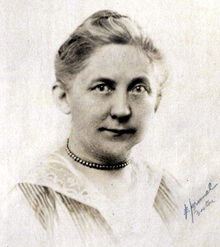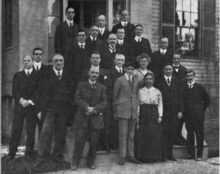Ida E. Woods
Ida E. Woods | |
|---|---|
 ca. 1893 | |
| Born | Ida Elizabeth Woods September 16, 1870 |
| Died | October 4, 1940 (aged 70) Natick, Massachusetts |
| Nationality | American |
| Scientific career | |
| Fields | Astronomy |
Ida E. Woods (September 16, 1870 – October 4, 1940) was an American astronomer at Harvard College Observatory.
Early life[]
Ida Elizabeth Woods was born in Natick, Massachusetts, the daughter of Oliver Powers Woods and Martha Wright Woods. She graduated from Wellesley College in 1893.[1][2]
Career[]
As a "computer" at Harvard College Observatory, beginning immediately after college in 1893,[3] Woods worked with Harlow Shapley and Annie Jump Cannon. She studied photographic plates to discover dozens of variable stars during her career.[1][4][5][6] She attended the meeting of the American Association of Variable Star Observers (AAVSO) in 1916, when it was held at Harvard.[7]
Publications by Woods included "Light Curve and Orbit of a New Eclipsing Binary H. V. 3622" (1922),[8] "Fifty New Variable Stars in the Southern Milky Way" (1926),[9] "The Southern Station of the Harvard Observatory" (1927),[10] and "Forty New Variable Stars in Sagitarrius" (1928).[11]

She held the Sarah F. Whitin Fellowship from Wellesley in 1912, to fund her research at Harvard.[12][13] She was a member of the Sagamore Sociological Conference.[14]
Personal life[]
Woods died in 1940, at her home in Natick. She was 70 years old.[15]
References[]
- ^ a b "Miss Ida E. Woods". The New York Times. October 6, 1940. p. 51 – via ProQuest.
- ^ "Degrees Conferred in 1893" ''Calendar'' (Wellesley College 1894): 95.
- ^ "Alumnae Notes" The Wellesley Magazine (November 1893): 114.
- ^ Bailey, Solon (1922). "Photographic Work at Arequipa with the Bruce 24-Inch Refractor. N.G.C. 3201". Harvard College Observatory Circular. 234: 1–3. Bibcode:1922HarCi.234....1B.
- ^ Bailey, Solon I. (Solon Irving) (1931). The history and work of Harvard observatory, 1839 to 1927; an outline of the origin, development, and researches of the Astronomical observatory of Harvard college together with brief biographies of its leading members. Osmania University, Digital Library Of India. New York, London, Pub. for the Observatory by the McGraw-Hill book company, inc. pp. 188.
- ^ "Women Discover New Star". The Boston Globe. December 21, 1919. p. 33. Retrieved June 11, 2019 – via Newspapers.com.
- ^ "The Annual Meeting of the American Association of Variable Star Observers". Popular Astronomy. 25: 69. 1916.
- ^ Woods, Ida E.; Shapley, Martha B. (1922). Light Curve and Orbit of a New Eclipsing Binary H. V. 3622. Harvard College Observatory Circular. p. 186.
- ^ Woods, I. E. (April 1926). "Fifty New Variable Stars in the Southern Milky Way". Harvard College Observatory Bulletin. 834: 14. Bibcode:1926BHarO.834...14W.
- ^ Woods, Ida E. "The Southern Station of the Harvard Observatory" Harvard College Observatory Bulletin (October 1927): 1.
- ^ Ida E. Woods, "Forty New Variable Stars in Sagittarius" Harvard College Observatory Bulletin (February 1928): 22.
- ^ "Going to Harvard". The Boston Globe. June 6, 1912. p. 12. Retrieved June 12, 2019 – via Newspapers.com.
- ^ Wellesley College (1915). Annual Reports of President and Treasurer. p. 13.
- ^ Sagamore Sociological Conference, Sagamore Beach, Massachusetts. 1907. p. 96.
- ^ "Miss Ida E. Woods Dead in Natick". The Boston Globe. October 5, 1940. p. 2. Retrieved June 11, 2019 – via Newspapers.com.
External links[]
- Ida E. Woods at Find a Grave
- Dava Sobel (2016). The Glass Universe: How the Ladies of the Harvard Observatory Took the Measure of the Stars. Viking. ISBN 978-0670016952.
- 1870 births
- 1940 deaths
- American women astronomers
- Wellesley College alumni
- People from Natick, Massachusetts
- 19th-century American astronomers
- 19th-century American women scientists
- 20th-century American astronomers
- 20th-century American women scientists
- Scientists from Massachusetts